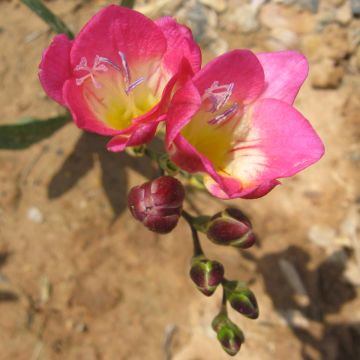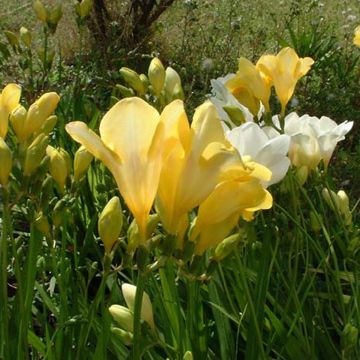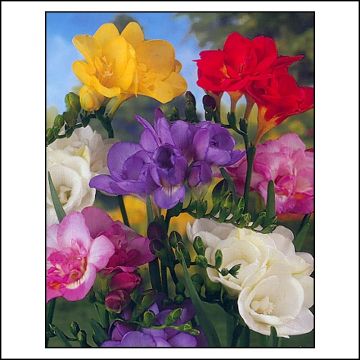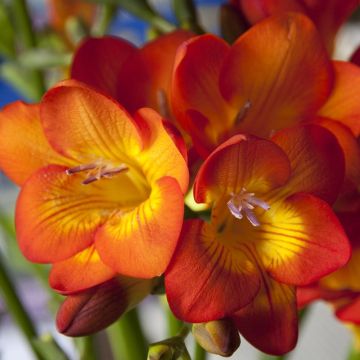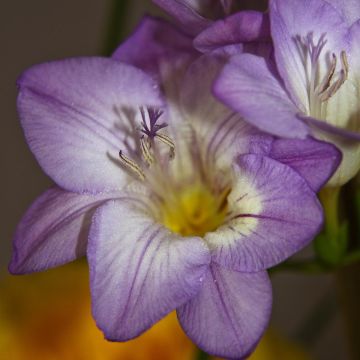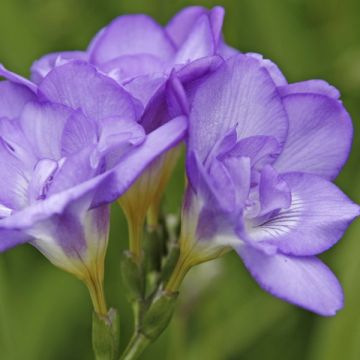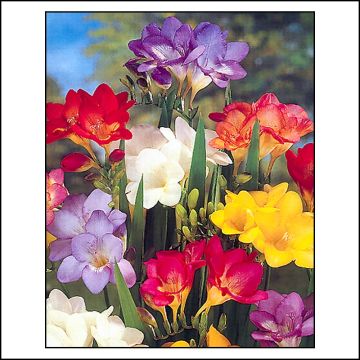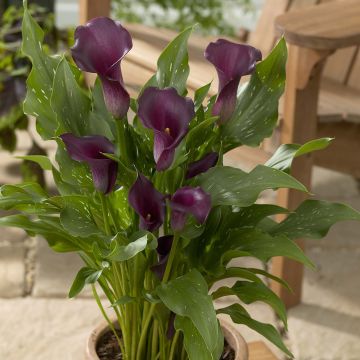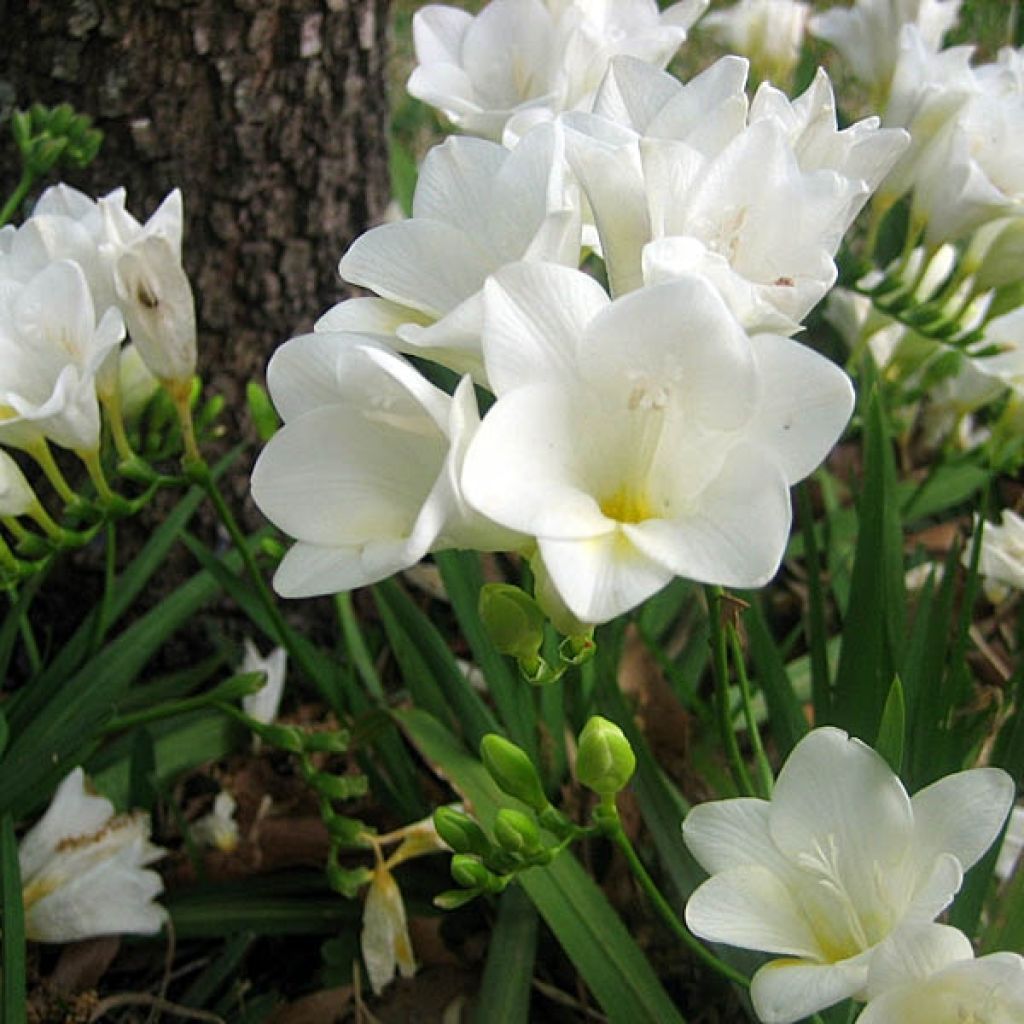

Freesia Simple Blanc
Freesia Simple Blanc
Freesia hybrida Simple Blanc
Freesia, Hybrid Freesia
Nothing to complain about regarding the delivery, packaging, etc... perfect! I just hope that the flowers will be as white as ordered because previously, with other orders, I received a lot of yellow ones instead of white ones.
Graziella , Nadadouro Portugal, 12/03/2024
This item cannot be shipped to the selected country
Delivery charge from €5.90
More information
Schedule delivery date,
and select date in basket
This plant carries a 6 months recovery warranty
More information
We guarantee the quality of our plants for a full growing cycle, and will replace at our expense any plant that fails to recover under normal climatic and planting conditions.
From €5.90 for pickup delivery and €6.90 for home delivery
Express home delivery from €8.90.
Does this plant fit my garden?
Set up your Plantfit profile →
Description
The White Freesia or Cape Lily is a bulbous plant that has been popular among florists for a long time. Its beautiful flower spikes, adorned with lovely white and highly fragrant cups, are perfect for creating delicate bouquets. If you have a very mild climate, you can plant it at the edge of flower beds to attract bees and brighten up the front stage. However, if your winters are chilly, it is more practical to grow it in a pot. This way, windowsills and entrances can benefit from its beauty and powerful fragrance.
As its name suggests, the Cape Lily is native to South Africa and was discovered in the late 19th century. It is a perennial that thrives in warm weather, prefers a sunny exposure, and cannot tolerate any frost at all. Therefore, you will need to store the bulb (more precisely, the corm) if your region is prone to frost. However, in mild climates, it can remain in the ground and benefit from protective mulching. Its flowering period will depend on the season in which it is planted. If planted in autumn, it will bloom in April-May. If planted in spring, it will perfume the summer. Its habit (35 cm (14in) tall) allows it to fit among spring bulbs. It has a compact size: its leaves, which are deciduous, are flat, linear, and sheathing. Its silhouette is mainly marked by curved flower spikes that bear delicate flowers arranged in unilateral clusters. They measure 2 to 3 cm (1in) long, have a tubular shape, and open into cups. They are a very milky white with just a hint of yellow at the base, and they release prominent stamens from the tube. They emit a sweet and sugary fragrance and also delight pollinators.
The White Freesia can be tamed for the pleasure of the senses. In warm regions, it will weave its way among spring bulbs to bring its fresh and pearly hue. Under less favorable skies, it will bloom in summer at the edge of pathways to illuminate and perfume the passage. If you have a cold greenhouse or a conservatory, opt for pot cultivation. This way, you can enjoy early flowering and move it according to the sun.
Report an error about the product description
Plant habit
Flowering
Foliage
Botanical data
Freesia
hybrida
Simple Blanc
Iridacées
Freesia, Hybrid Freesia
South Africa
Other Freesia
Planting and care
The white Freesia should be planted in well-drained soil, preferably slightly sandy. It should be rich and moist, but not excessively so, and preferably neutral to acidic. Sun exposure and protection from frost are essential, as it cannot tolerate temperatures below -5 °C (23°F). If your climate is mild (without or with few frost periods), you can plant it directly in autumn. You can mulch it to protect it. If you are concerned about frost, there are two options. You can plant the corm (under 5 cm (2in) of substrate) in spring once the frost periods have passed. The soil must be well-drained. After the foliage has dried out (in late summer), the bulbs should be dug up and stored in a dry and cool place, protected from frost, for planting the following year. Alternatively, you can grow them in pots for easier relocation and storage. In this case, you can plant the Freesias in spring or autumn: 5 to 7 per 15 cm (6in) diameter pots in a mixture of sand, potting soil, and turf.
Planting period
Intended location
Care
-
, onOrder confirmed
Reply from on Promesse de fleurs
Bulbs to grow in pots
Haven't found what you were looking for?
Hardiness is the lowest winter temperature a plant can endure without suffering serious damage or even dying. However, hardiness is affected by location (a sheltered area, such as a patio), protection (winter cover) and soil type (hardiness is improved by well-drained soil).

Photo Sharing Terms & Conditions
In order to encourage gardeners to interact and share their experiences, Promesse de fleurs offers various media enabling content to be uploaded onto its Site - in particular via the ‘Photo sharing’ module.
The User agrees to refrain from:
- Posting any content that is illegal, prejudicial, insulting, racist, inciteful to hatred, revisionist, contrary to public decency, that infringes on privacy or on the privacy rights of third parties, in particular the publicity rights of persons and goods, intellectual property rights, or the right to privacy.
- Submitting content on behalf of a third party;
- Impersonate the identity of a third party and/or publish any personal information about a third party;
In general, the User undertakes to refrain from any unethical behaviour.
All Content (in particular text, comments, files, images, photos, videos, creative works, etc.), which may be subject to property or intellectual property rights, image or other private rights, shall remain the property of the User, subject to the limited rights granted by the terms of the licence granted by Promesse de fleurs as stated below. Users are at liberty to publish or not to publish such Content on the Site, notably via the ‘Photo Sharing’ facility, and accept that this Content shall be made public and freely accessible, notably on the Internet.
Users further acknowledge, undertake to have ,and guarantee that they hold all necessary rights and permissions to publish such material on the Site, in particular with regard to the legislation in force pertaining to any privacy, property, intellectual property, image, or contractual rights, or rights of any other nature. By publishing such Content on the Site, Users acknowledge accepting full liability as publishers of the Content within the meaning of the law, and grant Promesse de fleurs, free of charge, an inclusive, worldwide licence for the said Content for the entire duration of its publication, including all reproduction, representation, up/downloading, displaying, performing, transmission, and storage rights.
Users also grant permission for their name to be linked to the Content and accept that this link may not always be made available.
By engaging in posting material, Users consent to their Content becoming automatically accessible on the Internet, in particular on other sites and/or blogs and/or web pages of the Promesse de fleurs site, including in particular social pages and the Promesse de fleurs catalogue.
Users may secure the removal of entrusted content free of charge by issuing a simple request via our contact form.
The flowering period indicated on our website applies to countries and regions located in USDA zone 8 (France, the United Kingdom, Ireland, the Netherlands, etc.)
It will vary according to where you live:
- In zones 9 to 10 (Italy, Spain, Greece, etc.), flowering will occur about 2 to 4 weeks earlier.
- In zones 6 to 7 (Germany, Poland, Slovenia, and lower mountainous regions), flowering will be delayed by 2 to 3 weeks.
- In zone 5 (Central Europe, Scandinavia), blooming will be delayed by 3 to 5 weeks.
In temperate climates, pruning of spring-flowering shrubs (forsythia, spireas, etc.) should be done just after flowering.
Pruning of summer-flowering shrubs (Indian Lilac, Perovskia, etc.) can be done in winter or spring.
In cold regions as well as with frost-sensitive plants, avoid pruning too early when severe frosts may still occur.
The planting period indicated on our website applies to countries and regions located in USDA zone 8 (France, United Kingdom, Ireland, Netherlands).
It will vary according to where you live:
- In Mediterranean zones (Marseille, Madrid, Milan, etc.), autumn and winter are the best planting periods.
- In continental zones (Strasbourg, Munich, Vienna, etc.), delay planting by 2 to 3 weeks in spring and bring it forward by 2 to 4 weeks in autumn.
- In mountainous regions (the Alps, Pyrenees, Carpathians, etc.), it is best to plant in late spring (May-June) or late summer (August-September).
The harvesting period indicated on our website applies to countries and regions in USDA zone 8 (France, England, Ireland, the Netherlands).
In colder areas (Scandinavia, Poland, Austria...) fruit and vegetable harvests are likely to be delayed by 3-4 weeks.
In warmer areas (Italy, Spain, Greece, etc.), harvesting will probably take place earlier, depending on weather conditions.
The sowing periods indicated on our website apply to countries and regions within USDA Zone 8 (France, UK, Ireland, Netherlands).
In colder areas (Scandinavia, Poland, Austria...), delay any outdoor sowing by 3-4 weeks, or sow under glass.
In warmer climes (Italy, Spain, Greece, etc.), bring outdoor sowing forward by a few weeks.

































